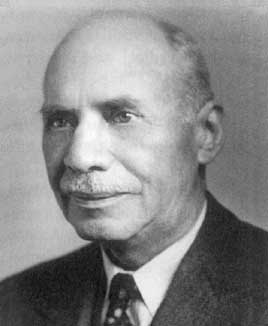
Hans Frederick Blichfeldt
 المؤلف:
G H Miller
المؤلف:
G H Miller
 المصدر:
Biography in Dictionary of Scientific Biography
المصدر:
Biography in Dictionary of Scientific Biography
 الجزء والصفحة:
...
الجزء والصفحة:
...
 15-4-2017
15-4-2017
 736
736
Born: 9 January 1873 in Illar, Denmark
Died: 16 November 1945 in Palo Alto, California, USA

Hans Blichfeldt's father, Erhard Christoffer Laurentius Blichfeldt, was farmer. However this broke with a long tradition in the family who were ministers of the church. Erhard Blichfeldt married Nielsine Maria Scholer and their son Hans soon showed remarkable mathematical ability. Despite the family being poor, they were well educated and Hans's father helped him with his studies. Hans showed a talent for all subjects, but he shone in mathematics.
At an early age Hans took the university entrance examinations. He passed with distinction but his parents were too poor to be able to afford to send him to university. Looking for a better life and to escape the poverty which they lived in, Hans's family decided to emigrate to the United States when he was 15 years of age. This was not the immediate solution to all of Hans's problems for once in the United States he spent four years as a labourer working on farms and in sawmills. It was hard work for the young man, so when he became a surveyor travelling round the country, it was a step towards a better life.
As a surveyor Blichfeldt had the opportunity to show his mathematical skills. All his colleagues marvelled at his ability to do mental arithmetic calculations of great complexity. Although this is no real sign of mathematical ability, it is usually taken as such by non-mathematicians and in the case of Blichfeldt his fellow surveyors were absolutely correct in persuading him to study mathematics at university.
Stanford University at Stanford, California was founded in 1885 by the railroad magnate Leland Stanford and his wife and the university was dedicated to their deceased only child, Leland. The first intake of students to the university was in 1891 and three years later in 1894 Blichfeldt began his mathematical studies there. He was awarded a B.A. in 1896 and the following year Stanford awarded him a Master's Degree. At this time it was the custom for American students wishing to study for a doctorate to go to Europe. It would be fair to say that Germany was the strongest country for mathematical research at this time and indeed most American students studied for their mathematical doctorates there.
To study in Europe, however, required money and Blichfeldt was not well off. He would certainly not have been able to find enough money without the generous help of one of his Stanford professors, Rufus L Green, who gave Blichfeldt a loan of the necessary funds. He returned to Europe going to the University of Leipzig where he worked under Sophus Lie on transformation groups. Within a year Blichfeldt submitted his dissertation On a certain class of groups of transformation in three-dimensional space which gained him a doctorate with distinction.
Returning to the United States, Blichfeldt worked as an instructor at Stanford beginning in 1898. By 1913 he had reached the rank of full professor. In 1927 he was appointed as Head of the Department of Mathematics at Stanford and he remained in this post until he retired in 1938. It is a remarkable story of achievement how Blichfeldt started his working life as a labourer and ended his career as head of department of a major university.
His research was on group theory and number theory, covering many topics within these areas. Miller writes in [1]:-
His lifework was devoted to group theory and number theory. Some of the many topics that he covered were diophantine approximations, orders of linear homogeneous groups, theory of geometry of numbers, approximate solutions of the integers of a set of linear equations, low-velocity fire angle, finite collineation groups, and characteristic roots.
Blichfeldt wrote papers on the geometry of numbers and he has an important book Finite Collineation Groups. He co-authored Theory and Application of Finite Groups with G A Miller and Dickson.
In [3] Hlawka looks at Blichfeldt's contributions to the geometry of numbers, in particular looking at Blichfeldt's principle. He also comments on what sort of man Blichfeldt was.
- G H Miller, Biography in Dictionary of Scientific Biography (New York 1970-1990).
http://www.encyclopedia.com/doc/1G2-2830900483.html
Articles:
- L E Dickson, Obituary: Hans Frederik Blichfeldt, 1873-1945, Bull. Amer. Math. Soc. 53 (1947), 882-883.
- E Hlawka, 90 Jahre Geometrie der Zahlen, Yearbook : surveys of mathematics 1980 (Mannheim, 1980), 9-41.
 الاكثر قراءة في 1870to1874
الاكثر قراءة في 1870to1874
 اخر الاخبار
اخر الاخبار
اخبار العتبة العباسية المقدسة


